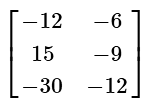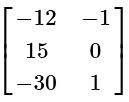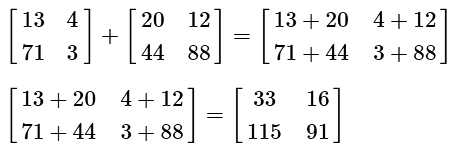Practice Questions: Matrices | Mathematics for ACT PDF Download
Q1: Evaluate:

(a)
(b)
(c)
(d)
 View Answer
View AnswerAns: (b)
This problem involves a scalar multiplication with a matrix. Simply distribute the negative three and multiply this value with every number in the 2 by 3 matrix. The rows and columns will not change.
Q2: Simplify:
(a)
(b)
(c)
(d)
 View Answer
View AnswerAns: (b)
Scalar multiplication and addition of matrices are both very easy. Just like regular scalar values, you do multiplication first:
The addition of matrices is very easy. You merely need to add them directly together, correlating the spaces directly.
Q3: Simplify the following

(a)
(b)
(c)
(d)
 View Answer
View AnswerAns: (d)
When multplying any matrix by a scalar quantity (3 in our case), we simply multiply each term in the matrix by the scalar.
Therefore, every number simply gets multiplied by 3, giving us our answer.
Q4:
(a)
(b)
(c)
(d)
 View Answer
View AnswerAns: (c)
When multiplying a constant to a matrix, multiply each entry in the matrix by the constant.
Q5: With matrix notation, what does M2x3 x N3x4 equal?
(a) None of the answers are correct
(b) P2x4
(c) P3x4
(d) P3x3
 View Answer
View AnswerAns: (b)
M2x3 x N3x4 = P2x4
In general matrix notation, Mrxc shows that the matrix is named M and r is the number of rows and c is the number of columns. When multiplying two matrices, the number of columns in the first matrix must match the number of rows in the second matrix. In addition, when adding or subtracting matrices, the matrices must be of the same size.
|
144 videos|100 docs|61 tests
|
FAQs on Practice Questions: Matrices - Mathematics for ACT
| 1. What are matrices in mathematics? |  |
| 2. How do you add and subtract matrices? |  |
| 3. What is the identity matrix? |  |
| 4. Can matrices be multiplied together? |  |
| 5. How do you find the determinant of a matrix? |  |

|
Explore Courses for ACT exam
|

|
















